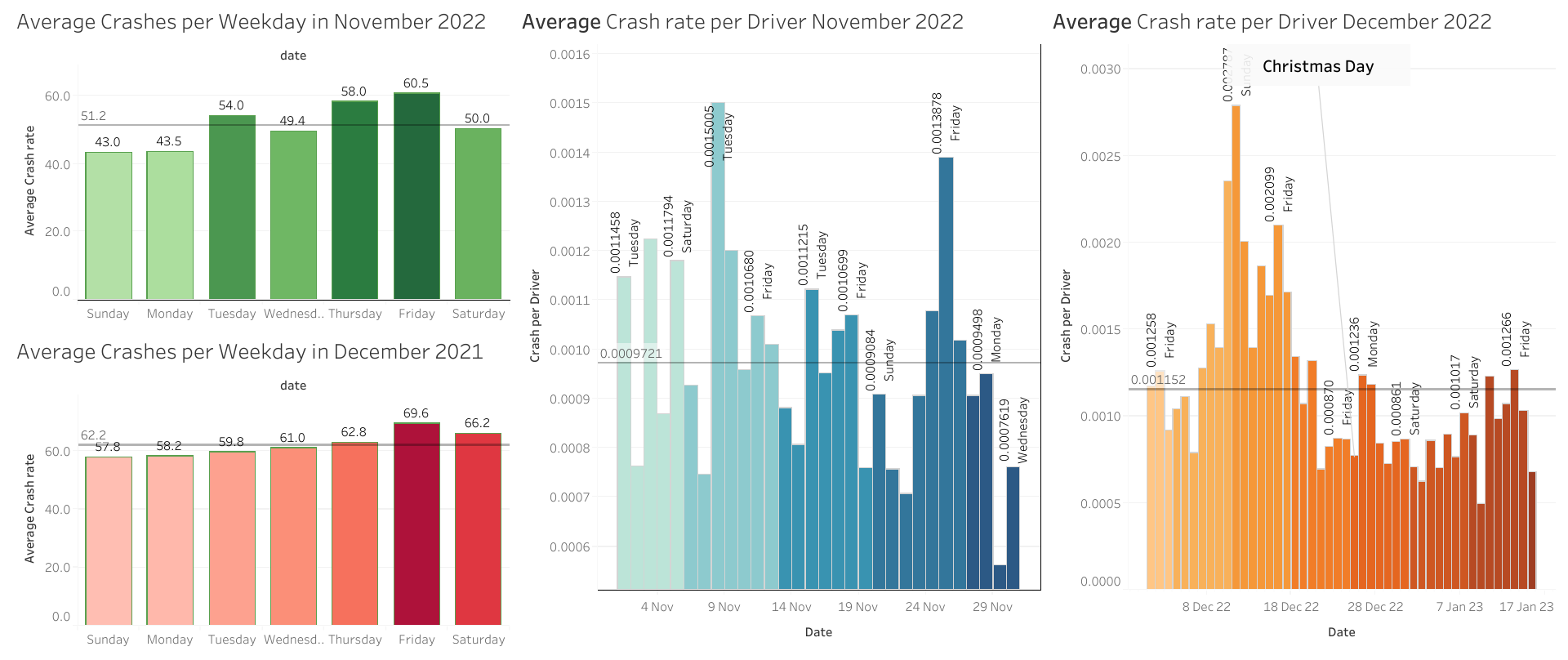The fact that December is a stressful month does not need scientific proof. But how exactly do the stress and the rush of Christmas and the ending of one more year affect our driving behaviour?
Our data analysts were curious: do the holidays impact the way we drive, or did something else make the average crash rate per driver 24% higher in December than in November 2022? After analysing 83 million trips made in the UK, we got some interesting conclusions…
We started by looking into how mobile the drivers are during the holiday season, focusing on the Christmas and New Year periods. Our premise was that running errands, frantically shopping and getting stuck in traffic were the reasons behind the weakened focus on the road.
UK road travel averages of 2022: Is the holiday season truly busier?
Compared with the data from the month of November, the average distance travelled per active driver in December generally stayed the same - 38km (24 miles).
However, for the 25th of December, Christmas day, the average journey length was 31km (19 miles), a significant 18% reduction. This effect is also seen with the second least travelled day of the festive season, which was on the 1st of January 2023, New Year's day. Our drivers’ total number of journeys on New Year's day was 40% less than the travels on the 1st of December, exactly one month apart.
The lowest average daily distance travelled by drivers during the whole of November was 35km (22 miles) per day, which is still 13% higher than on Christmas Day! On Christmas day, drivers took 56% fewer trips than December’s maximum only a couple of days before on the 23rd with 245,605 trips. This was the last Friday before Christmas, when the number of trips rose by 21% compared to the average for the month.
The maximum number of trips on a Saturday is for the 24th of December, Christmas Eve; with visits, this day has a 10.5% increase compared to the previous two Saturdays of the same month. This shows the travels unique to the events of this holiday period, e.g. Christmas Eve dinner.
Christmas day was the least travelled day of 2022, followed by the 19th of September, which was a bank holiday after Her Majesty passed away. The most travelled day of the year was on the 29th of April, preceding the early May bank holiday. 165% more travelling than compared to the lowest on Christmas.
Why are we riskier drivers during the holiday season?
So if we generally travel the same distances, most likely we are visiting the same places along the road, how is it that in familiar surroundings, we’re causing an increase of 24% in car crashes in December in the UK?
Luckily, MOTIX algorithms are able to take the weather conditions into account when answering this question.
The analysis showed that UK drivers are ~10 times more likely to crash when snowfall than when there is an equivalent measure of rainfall.
On the 11th of December, 2022, snow covered the UK, causing a spike in the number of
crashes; the crash rates increased by 70% compared to the month's average.

Statistics demonstrate that our drivers were still at risk of accidents until the snow
melted three days later, with crash rates continuing to be higher than average.
When it snowed on February 17th and 18th, 2022, the same pattern was seen; Although
the peak snowfall at that time was only a third of the late 2022 snowfall, it yet again
increased the crash rates by 47%; the lower crash proportion for this period may be due to the faster thawing of the snow, unlike in December.
Given all this information, it might be a good idea to take extra caution when driving in winter conditions: holiday season or not.
Learning from the data: Holidays are not an excuse for losing your wits at the wheel
By analysing trip data from 129,621 vehicles, we have discovered that increased stress and less patience around the holidays are not the primary reason why the roads are less safe: the 2022 driving style data suggests that drivers in the UK are not used to driving in the colder weather, snowfall and icy conditions, and the darker hours.

If you are not experienced in these driving conditions, we suggest you enjoy your rides on Sundays, since this is the day with the least traffic, leading to safer roads. With that in mind, know that from November to December, the highest number of crashes per day of the week generally belong to Fridays.
Now that we mapped out the reasons behind this, let’s look at what’s coming…
How can technology help in making traffic safer for drivers?
Besides monitoring traffic and weather conditions that may have an impact on driver behaviour at the wheel, today's advanced AI-based mobile applications can also monitor and correct that very behaviour.
When you’re identified as driving your vehicle, via connecting to your vehicle's Bluetooth signal like the built-in radio, the app can record the way you drove from point A to point B and, after every trip, provide you with a suggestion on how you could improve. Sharp turns, harsh braking and other features of your driving style can be corrected if you apply the recommendations and tips offered.
The benefits of this type of coaching are not limited to safety, although it’s the core advantage of having your phone turned into a telematics device. Many insurers provide their policyholders with an app like this, so depending on your driving style they can determine if you are a safe driver and reward you with discounts or other benefits.
In the end, a piece of old-school advice which is always in place: stay safe, mind the traffic and road conditions, do not ever drive under the influence of alcohol, and we just might have a better statistic in this report next year!